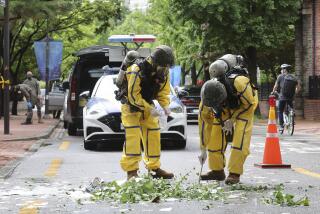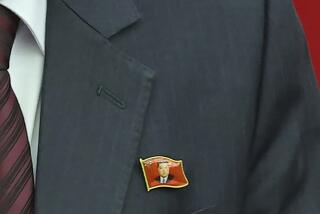No Gift Is Too Small for Them
- Share via
MT. MYOHYANG, North Korea — Most people receive a few gifts for their birthday. Maybe a dozen if it’s a big one. But a thousand?
Such outpourings for “Dear Leader” Kim Jong Il and his late father, “Great Leader” Kim Il Sung, are evidence of the love and respect they engender the world over, our omnipresent North Korean guides inform us.
For the record:
12:00 a.m. Dec. 1, 2005 For The Record
Los Angeles Times Thursday December 01, 2005 Home Edition Main News Part A Page 2 National Desk 1 inches; 55 words Type of Material: Correction
North Korean leaders -- A photo caption in Friday’s Section A identified North Korean leader Kim Jong Il as the subject of a statue displayed at a North Korean museum. The statue is of his father and predecessor, the late Kim Il Sung. The caption also misspelled the younger leader’s name as Kim Jong Ill.
In fact, the elder Kim is so beloved that the gifts still pour in 11 years after his death. Add them up, and over the decades you have a dizzying 219,370 gifts for the Great Leader and 53,419 for the Dear Leader from around the globe. And they’re all stored here.
In a valley north of Pyongyang, the capital, is the one-of-a-kind International Friendship Exhibition museum. Some collectors build libraries to house their books and stamps. The Kims burrowed out a mountain, creating 200 underground rooms to hold what we’re told is every gift ever sent them from abroad.
The facades of the main buildings look like traditional Korean structures, but the museum is really a fortress. A close examination finds the windows merely painted on, to foil intruders. Guards stand at the 4.5-ton doors, their silver-plated machine guns loaded. The location deep in the mountains helps protect against bombings, we’re told. No need to ask who (powerful North American country with the initials U.S.A.) they’re worried about.
Inside, long hallways stretch into the distance as well-mannered guides dressed in traditional chima chogori whisk tourists in and out of a maze of rooms organized by year, nationality and the prominence of the gift-giver. Only extensive training, we’re told, keeps the guides from getting lost as they lead tour groups that range in size from the intimate (two) to the immense (up to 100).
To ensure the marble floors aren’t chipped, visitors must don cloth booties. Any violation of the rules draws a gasp. Midway through the tour, someone’s bootie gets caught in an escalator. General panic and consternation follow as guides rush about in different directions to resolve the crisis.
As the scope of the collection confirms, the Kims have not discriminated. Lava lamps have pride of place alongside Mercedes-Benz sedans. Plastic heart-shaped music boxes and tin spoons keep company with priceless Chinese sculptures. “Some gifts almost seem like they’re from Wal-Mart,” says tourist Ashok Roy, a doctor from Washington, D.C.
That’s because the Dear Leader senses the love in the gift, not the cost, our guides and minders helpfully explain. “Big ones, small ones, he never counts the value,” says Paek Hye Sim, 25, a five-year museum veteran. “He only considers what’s in the minds of the international people.”
One of the best ways to get your gift prominently positioned, by the looks of it, is to adorn it with a likeness of the Dear Leader or Great Leader. Take a cue from Syria, which spent months crafting a portrait of Kim Il Sung using Arabic calligraphy of the great man’s own writings. A glorious gift indeed.
The greatest honor goes to a wax image of Kim Il Sung given by China. Visitors are asked to straighten their clothes and bow respectfully at the diorama of Kim on Mt. Paekdu as a simulated wind makes the artificial grass rustle to the classical tones of the “Song of Gen. Kim Il Sung.”
Only a portion of the items are on display at any given time, and we’re told that to view all the gifts, with a one-minute stop in front of each one, would take a year and a half. Some of the collection is repetitive, with many gift-givers apparently concluding that the Kims needed one more dish. These are interspersed with beer coolers, however, and helpful books such as “Businessman’s Guide to the Finnish Sauna.”
Befitting a regime whose motto is “Army First,” there are many gifts of weaponry -- pistols from Laos, machine guns from Zambia, shotguns from Russia. Kim Il Sung was an excellent hunter, we’re told, able “of course” to bag far-off game with a single shot.
The collection provides a trip back in time, and not just in terms of fashion or lamp styles. On prominent display are offerings from many of Kim Il Sung’s closest communist allies.
Josef Stalin gave a beautifully appointed train carriage in August 1945, the first international gift Kim Il Sung received en route to power. It took the Americans decades to even come up with a fruit bowl. Not to be outdone, Mao weighed in a few years later with a Chinese train carriage. “Mao pays homage to Kim Il Sung!” a placard reads.
Both of the train cars are wood-paneled and elegant, fit for an emperor. The major difference appears to be that Stalin went in a bit more for tassels and Mao opted for an Asian-style squat toilet. How were these massive train cars wedged into this small room deep in the mountain? In a classic case of socialist planning, the museum was built around them, starting in 1977.
A few rooms away we find a limousine Stalin gave Kim Il Sung. The windows of the black Zil are dark and thick, reminiscent of an old Coke bottle. That’s the bulletproof glass. You can never be too careful. “Stalin especially respected Kim Il Sung,” our guide explains.
Down the hall is a bear pelt decked out with a white lace collar, a gift from the late Romanian dictator Nicolae Ceausescu that lends insight into Kim Il Sung’s modest side. “They offered him three stuffed bears, but he took the lowest grade of bear,” our guide says, “to be polite.”
Rounding out the collection are a crocodile briefcase from Cuban leader Fidel Castro, a model Sputnik from Leonid I. Brezhnev and a circa 1980 portable stereo from the Chinese leadership. The size of a suitcase, it is labeled “4 Band Stereo Cassette Recorder 4 Speakers.”
“I mean, a boombox?” says Carl Jacobson, a tourist living in Thailand.
The gifts chart North Korean diplomacy. The more lavish offerings from communist bloc countries tail off by the late 1980s. A decade later, however, rooms start filling up with South Korean electronics, furniture and golf clubs as North-South relations improve.
International media often report that North Korea is isolated diplomatically. The scope of the collection and a map with twinkling lights marking the scores of gift-giving countries appear aimed at suggesting otherwise. Some international friendships are better than others, however. The big-ticket items from the Kims’ communist pals far outshine the glass bowl given by former Secretary of State Madeleine Albright, a small dish and plate from former President Carter and a diminutive glass “global news” orb from CNN.
Has President Bush sent a special something for Kim Jong Il? “As of yet, it has not come,” our guide says.
As the tour wraps up, just before we’re deposited at the museum’s gift shop, Paek, the guide, suggests that the United Nations consider this complex a World Heritage Site. “Our president said these are a national treasure,” Paek says. “He handed the gifts over to be cherished by future generations.”
The experience leaves some tourists wondering whether they might give the Kims a gift as well. The staff informs them it’s possible.
Adam Malis, a tourist from Boca Raton, mulls giving a Florida key chain, a watch or his iPod, ultimately rejecting them all as inappropriate.
“I don’t think he’d like my music taste,” he says. “And Stalin gave a train. How could he be impressed with my little keychain?”
*
Magnier, The Times’ Beijing Bureau chief, was recently on assignment in North Korea.
More to Read
Sign up for The Wild
We’ll help you find the best places to hike, bike and run, as well as the perfect silent spots for meditation and yoga.
You may occasionally receive promotional content from the Los Angeles Times.






